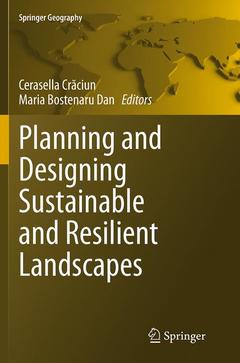Description
Planning and Designing Sustainable and Resilient Landscapes, 2014
Springer Geography Series
Coordinators: Crăciun Cerasella, Bostenaru Dan Maria
Language: English
Subjects for Planning and Designing Sustainable and Resilient Landscapes:
Publication date: 09-2016
Support: Print on demand
Publication date: 02-2014
303 p. · 15.5x23.5 cm · Hardback
Description
/li>Contents
/li>Biography
/li>Comment
/li>
Part I: Introduction – Research / Method / Transdisciplinarity – METABOLISM.- Pluri, Inter and Transdisciplinarity Methods in Researching the Landscape Metabolism.- Part II: Archetypal landscape – Philosophy / Epistemology / Semiotics – SPECIFICITY.- Living the space from Ţara Haţegului - Building places and landscape as collective identity and memory.- Decoding Agricultural Landscape.- Part III Cultural landscape – Image / Photo / Space and Time – MEMORY.- Inventing Scotland: Photography, Landscape and National Identity.- Photography as exercise of memory in order to re-asses, re-compose and revive landscapes.- Part IV Ecological landscape – Cartography / Assessments / Geography – DYNAMICS.- Forest landscape history using diachronic cartography and GIS. Case study: Subcarpathian Prahova Valley, Romania.- GIS-based methodology for the analysis of regional landscapes and their changes based on land cover and use: a planning perspective aimed at conserving the natural heritage.- Part V Transition landscape – Periphery / Consumption / Decision – REAPPRAISAL.- Urban Culture, Urban Cultural Landscape.- The landscape of the urban peripheries- an alternative therapy.- Part VI Urban garden – Art / History / Landscape Architecture – BECOMING.- Viennese Modernism and Landscape Architecture.- Green walls.- Part VII Urban landscape – Revitalisation / Itinerary / Perception – ROUTE.- Spatial street network and urban traces around the Modernist boulevard in Bucharest.- Landscape rehabilitation through policies and urban interventions for reshaping mobility.- Part VIII Public space – Exercise / Project / Intervention – PARTICIPATION.- Living landscapes.- Reconditioning the urban texture through public interventions.- Media landscape.- Part IX Conclusion – Territory / Detail / Resilience –SUSTAINABILITY.- Part IX Conclusion – Territory / Detail / Resilience–SUSTAINABILITY.- Planning and designing sustainable and resilient landscapes – Conclusions and recommendations for further work.
Cerasella Crăciun is PhD, Associate Professor Architect, Vice-Dean of the Urban Planning Faculty, Head of the study direction "Landscape architecture" at the "Ion Mincu" University of Architecture and Urbanism (both masters and undergraduate).
Maria Bostenaru-Dan is PhD, research scientist at the “Ion Mincu” University of Architecture and Urbanism. She came back to her home country of Romania after spending more than a decade abroad, in Karlsruhe, Germany, where she graduated and in Pavia, Italy.




